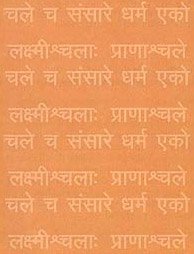Pakshin, Pakṣi, Pakṣī, Pakṣin, Pakshi: 37 definitions
Introduction:
Pakshin means something in Buddhism, Pali, Hinduism, Sanskrit, Jainism, Prakrit, the history of ancient India, Marathi, Hindi, Tamil. If you want to know the exact meaning, history, etymology or English translation of this term then check out the descriptions on this page. Add your comment or reference to a book if you want to contribute to this summary article.
The Sanskrit terms Pakṣi and Pakṣī and Pakṣin can be transliterated into English as Paksi or Pakshi or Paksin or Pakshin, using the IAST transliteration scheme (?).
Images (photo gallery)
In Hinduism
Purana and Itihasa (epic history)
Source: Wisdom Library: Viṣṇu-purāṇaPakṣī (पक्षी) refers to “birds” and represents a type of Ādhibhautika (one of the three types of worldly pain), according to the Viṣṇu-purāṇa 6.5.1-6. Accordingly, “the wise man having investigated the three kinds of worldly pain, or mental and bodily affliction and the like, and having acquired true wisdom, and detachment from human objects, obtains final dissolution.”
Source: Wisdom Library: Skanda-puranaPakṣin (पक्षिन्) refers to “birds” (living in the Kuśasthalī forest), according to the Skandapurāṇa 2.2.13 (“The Greatness of Kapoteśa and Bilveśvara”).—Accordingly: as Jaimini said to the Sages: “[...] [Dhūrjaṭi (Śiva)] went to the holy spot Kuśasthalī. He performed a very severe penance near Nīla mountain. [...] By the power of his penance that holy spot became one comparable to Vṛndāvana, the forest near Gokula. [...] It was full of different kinds of flocks of birds [i.e., nānā-pakṣin-gaṇākīrṇa]. It was a comfortable place of resort for all creatures. Since by means of his penance Śiva became (small) like a dove, he came to be called Kapoteśvara at the behest of Murāri (Viṣṇu). It is at his bidding that the Three-eyed Lord always stays here along with Mṛḍānī (Pārvatī)”.
Source: Wisdom Library: Padma-puranaPakṣin (पक्षिन्) refers to “birds” (living in temples), according to the Padmapurāṇa 5.87 (“Subtle Are the Ways of Dharma”).—Accordingly, as Viṣṇu praises Brahmā:—“[...] This month of Vaiśākha is dear to the great-souled Viṣṇu. Even if one is observed (i.e. even if bath etc. is done in only one Vaiśākha) by people, it gives the entire desired (object). O king, this is my view that a man who is given to bathing (right) from his birth with the holy water of Gaṅgā at the proper time and place, who is void of devotion and yet is a giver, does not become pure. Creatures live at holy places on Gaṅgā etc. and flocks of birds [i.e., pakṣin-gaṇa] always live in temple(s). (Though) they observe fasts, they, being bereft of devotion, meet with death, and do not get the (highest) position (i.e. salvation)”.
Source: Google Books: Cultural History from the Vāyu PurānaPakṣi (पक्षि) falls under the category of wild beasts (āraṇya-paśu) according to the Vāyu Purāṇa.
Source: archive.org: Shiva Purana - English TranslationPakṣin (पक्षिन्) refers to “birds” (living in temples), according to the Śivapurāṇa 5.23.—Accordingly, as Sanatkumāra said: “O Vyāsa, O highly intelligent sage, listen to the impurity of the body and the greatness of good feelings. I shall explain briefly. [...] Fishes stay in the holy Gaṅgā and other sacred rivers. Flocks of birds [i.e., pakṣin-gaṇa] stay in the temple. They do not attain any special benefit from the ceremonial ablutions and charitable gifts since they are devoid of holy feelings. It is the purity of the feelings that is the criterion for the sanctity of rites. The wife is embraced with one feeling and the daughter is embraced with another. [...]”.
Source: Cologne Digital Sanskrit Dictionaries: The Purana IndexPakṣi (पक्षि).—A species of birds vanquished by Rāvaṇa; the name of a mūrchana after their name.*
- * Brahmāṇḍa-purāṇa III. 7. 256, 307; 61. 52; IV. 4. 2.
Pakṣī (पक्षी) or Pakṣin refers to “birds” (living in the forest), according to the Rāmāyaṇa chapter 2.29. Accordingly:—“[...] Sītā was distressed to hear these words of Rāma and spoke these words slowly, with her face with tears: ‘[...] Oh Rāma! Antelopes, lions, elephants, tigers, Śarabhas (legendary animal with eight legs), birds (pakṣī), yaks and all others which roam in the forest, run away after seeing your form, since they have never seen your figure before. When there is cause for fear, who would not have fear?’”.

The Purana (पुराण, purāṇas) refers to Sanskrit literature preserving ancient India’s vast cultural history, including historical legends, religious ceremonies, various arts and sciences. The eighteen mahapuranas total over 400,000 shlokas (metrical couplets) and date to at least several centuries BCE.
Samkhya (school of philosophy)
Source: Wisdom Library: Sāṃkhya philosophyPakṣī (पक्षी) refers to “winged animals” such as birds, swans, vultures, insects or mosquitoes, and represents a division of the animal world (tairyaksarga) according to the Sāṃkhyakārikā. The tairyaksarga is one of the three types of elemental creation, also known as bhautikasarga.
The Sāṃkhyakārikā by Iśvarakṛṣṇa is the earliest extant text of the Sāṃkhya school of philosophy and dates from the 4th century CE. It contains 72 Sanskrit verses and contents include epistemology and the theory of causation.

Samkhya (सांख्य, Sāṃkhya) is a dualistic school of Hindu philosophy (astika) and is closeley related to the Yoga school. Samkhya philosophy accepts three pramanas (‘proofs’) only as valid means of gaining knowledge. Another important concept is their theory of evolution, revolving around prakriti (matter) and purusha (consciousness).
Shilpashastra (iconography)
Source: Shodhganga: The significance of the mūla-beras (śilpa)Pakṣi (पक्षि, “bird”) refers to one of the several “attributes” (āyudha) or “accessories” of a detiy commonly seen depicted in Hindu iconography, defined according to texts dealing with śilpa (arts and crafs), known as śilpaśāstras.—The śilpa texts have classified the various accessories under the broad heading of āyudha or karuvi (implement), including even flowers, animals, and musical instruments. The representations of certain animals and birds are generally found in the hands of images. They are, for example, Pakṣi.

Shilpashastra (शिल्पशास्त्र, śilpaśāstra) represents the ancient Indian science (shastra) of creative arts (shilpa) such as sculpture, iconography and painting. Closely related to Vastushastra (architecture), they often share the same literature.
Shaktism (Shakta philosophy)
Source: Google Books: ManthanabhairavatantramPakṣin (पक्षिन्) refers to “birds”, according to the Kularatnapañcakāvatāra verse 1.23cd-33ab.—Accordingly, “[...] (Whereas) those who know the reality of Kula are born from the path of Kula. Once drunk the divine nectar of Kula there is no rebirth again. Kaula is the permutation of those two and abides in the form of the individual soul. Nothing arises without that in the mobile and immobile universe. When known, the gods, demons, people, animals, vegetation and birds (pakṣin) dissolve away (into the absolute). O dear one, the cause of that is Kaula. As the triple universe along with the gods, demons and men, belongs to Kaula, it is said to be Kaula, the cause of the birth of the body”.

Shakta (शाक्त, śākta) or Shaktism (śāktism) represents a tradition of Hinduism where the Goddess (Devi) is revered and worshipped. Shakta literature includes a range of scriptures, including various Agamas and Tantras, although its roots may be traced back to the Vedas.
Sports, Arts and Entertainment (wordly enjoyments)
Source: archive.org: Syainika Sastra of Rudradeva with English Translation (art)Pakṣin (पक्षिन्) refers to “birds” (which were commonly the victim of hunting), according to the Śyainika-śāstra: a Sanskrit treatise dealing with the divisions and benefits of Hunting and Hawking, written by Rājā Rudradeva (or Candradeva) in possibly the 13th century.—Accordingly, “[Hunting by snares] [...] is useful in the capturing of elephants, etc. Therefore kings should also have recourse to it as it is exceedingly profitable. [...] When, on account of their training, deer capture deer, and birds (pakṣin) capture birds [pakṣiṇaścāpi pakṣiṇaḥ], that is also included under this head”.

This section covers the skills and profiencies of the Kalas (“performing arts”) and Shastras (“sciences”) involving ancient Indian traditions of sports, games, arts, entertainment, love-making and other means of wordly enjoyments. Traditionally these topics were dealt with in Sanskrit treatises explaing the philosophy and the justification of enjoying the pleasures of the senses.
In Buddhism
Mahayana (major branch of Buddhism)
Source: Wisdom Library: Maha Prajnaparamita SastraPakṣin (पक्षिन्, “birds”) represents an incarnation destination of the tiryaggati (animal realm) according to the “world of transmigration” section in the 2nd century Mahāprajñāpāramitāśāstra (chapter XXVII).—The Bodhisattva sees the animals (tiryak) undergoing all the torments: they are made to gallop by blows of the whip or stick; they are made to make long journeys carrying burdens; their harness is damaged; they are branded with hot iron. As a result of all these passions (saṃyojana) and all these actions (karman), they undergo the sufferings reserved for animals (tiryak), birds (pakṣin) or quadrupeds (paśu).
Source: De Gruyter: A Buddhist Ritual Manual on AgriculturePakṣin (पक्षिन्) refers to a “bird” (e.g., ‘a Garuḍa speed bird’), according to the Vajratuṇḍasamayakalparāja, an ancient Buddhist ritual manual on agriculture from the 5th-century (or earlier), containing various instructions for the Sangha to provide agriculture-related services to laypeople including rain-making, weather control and crop protection.—Accordingly, [As the Bhagavān gives instructions for protection of crops]: “[...] They will be well protected. There will be a sealing of the boundaries for all Nāgas: the slopes of the great fire-mountain will completely cover the four directions and the great fire blaze mass cloud that is the expanded [wings] of the Garuḍa speed bird (pakṣi-vijṛmbhita), called a great mass, will cover the sky. It is there for the protection of all flowers and fruits. All Nāgas and so on will be burnt by that. All harmful Nāgas will be destroyed”.

Mahayana (महायान, mahāyāna) is a major branch of Buddhism focusing on the path of a Bodhisattva (spiritual aspirants/ enlightened beings). Extant literature is vast and primarely composed in the Sanskrit language. There are many sūtras of which some of the earliest are the various Prajñāpāramitā sūtras.
Tibetan Buddhism (Vajrayana or tantric Buddhism)
Source: Wisdom Library: Tibetan BuddhismPakṣin (पक्षिन्) refers to a group of deities summoned by the Yamāntaka-mantra and mentioned as attending the teachings in the 6th century Mañjuśrīmūlakalpa: one of the largest Kriyā Tantras devoted to Mañjuśrī (the Bodhisattva of wisdom) representing an encyclopedia of knowledge primarily concerned with ritualistic elements in Buddhism. The teachings in this text originate from Mañjuśrī and were taught to and by Buddha Śākyamuni in the presence of a large audience (including Pakṣin).
Source: ORA: Amanaska (king of all yogas): (Tibetan Buddhism)Pakṣin (पक्षिन्) refers to a “bird”, according to verse 14.24bd-27 of the Laghuśaṃvara, an ancient Buddhist Yoginī Tantra.—Accordingly, [while describing the Siddhi of speech]: “The Sādhaka [who has] the Siddhi of speech can certainly attract a king or queen by [merely] thinking [it]. He quickly controls gods, demons and men. When angry, he can kill with his speech and drive away his adversary. The practitioner can thus effect a curse with his speech. And he can stop a river, a cart, a machine [like a water-wheel,] the ocean, elephants and horses, clouds, a man or bird (pakṣin) [pakṣiṇam] merely by means of his speech. He achieves everything which he desires by his speech”.

Tibetan Buddhism includes schools such as Nyingma, Kadampa, Kagyu and Gelug. Their primary canon of literature is divided in two broad categories: The Kangyur, which consists of Buddha’s words, and the Tengyur, which includes commentaries from various sources. Esotericism and tantra techniques (vajrayāna) are collected indepently.
In Jainism
General definition (in Jainism)
Source: The University of Sydney: A study of the Twelve Reflections1) Pakṣi (पक्षि) refers to “birds”, according to Pūjyapāda’s Sarvārthasiddhi.—Accordingly, “[...] And even among the five-sensed beings, many belong to the animal world such as the cow, the deer, the bird (pakṣi), the serpent, etc. Hence human birth is as difficult of attainment as a heap of jewels at the crossing of the roads. And if one loses the condition of a human being by negligence, it is as difficult to attain it once again, as it is difficult for a burnt tree to regain its old freshness. Even if human birth is attained, a good country, a good family, keen senses, health, etc. are more and more difficult of attainment. [...]”.
2) Pakṣin (पक्षिन्) refers to “birds”, according to the 11th century Jñānārṇava, a treatise on Jain Yoga in roughly 2200 Sanskrit verses composed by Śubhacandra.—Accordingly, “Having abandoned the tree, as the birds [com.—pakṣin] go in the early morning, in like manner the embodied souls continually go somewhere depending on their own karma”.
Synonyms: Patrin.
Source: academia.edu: The Original Paṇhavāyaraṇa/Praśnavyākaraṇa DiscoveredPakṣin (पक्षिन्) refers to “birds”, as taught in the Paṇhavāgaraṇa (Sanskrit: Praśnavyākaraṇa): the tenth Anga of the Jain canon which deals with the prophetic explanation of queries regarding divination.—The Praśnavyākaraṇa deals with the praśnavidyā in a rather complex way. It is divided into at least 33 short chapters [e.g., pakṣī-adhikāra; part of the chapter called jīvacintā-prakaraṇa], some of which are further divided into sub-chapters. Some contents of the text, mainly those related with articulation and pronunciation can have significance far beyond the scope of the praśnavidyā.

Jainism is an Indian religion of Dharma whose doctrine revolves around harmlessness (ahimsa) towards every living being. The two major branches (Digambara and Svetambara) of Jainism stimulate self-control (or, shramana, ‘self-reliance’) and spiritual development through a path of peace for the soul to progess to the ultimate goal.
India history and geography
Source: Project Gutenberg: Castes and Tribes of Southern India, Volume 1Pakshi (“birds”) refers to a factor taken into consideration, by consulting an astrologer, before marriage among the Agamudaiyans (a cultivating case foundin all the Tamil districts).—Certain asterisms also belong to birds, and the birds of the pair should be on friendly terms, e.g., peacock and fowl.

The history of India traces the identification of countries, villages, towns and other regions of India, as well as mythology, zoology, royal dynasties, rulers, tribes, local festivities and traditions and regional languages. Ancient India enjoyed religious freedom and encourages the path of Dharma, a concept common to Buddhism, Hinduism, and Jainism.
Languages of India and abroad
Marathi-English dictionary
Source: DDSA: The Molesworth Marathi and English DictionaryPakṣī (पक्षी).—m (S) A winged creature, a fowl, a bird.
Source: DDSA: The Aryabhusan school dictionary, Marathi-EnglishPakṣī (पक्षी).—m A winged creature, a bird.
Marathi is an Indo-European language having over 70 million native speakers people in (predominantly) Maharashtra India. Marathi, like many other Indo-Aryan languages, evolved from early forms of Prakrit, which itself is a subset of Sanskrit, one of the most ancient languages of the world.
Sanskrit dictionary
Source: DDSA: The practical Sanskrit-English dictionaryPakṣin (पक्षिन्).—a. (-ṇī f.) [पक्ष अस्त्यर्थे इनि (pakṣa astyarthe ini)]
1) Winged; यें पक्षिणः प्रथममम्बुनिधिं गतास्ते (yeṃ pakṣiṇaḥ prathamamambunidhiṃ gatāste) Śiśupālavadha 5.31.
2) Furnished with wings.
3) Siding with, adhering to the party of. -m.
1) A bird.
2) An arrow.
3) An epithet of Śiva.
Source: Cologne Digital Sanskrit Dictionaries: Edgerton Buddhist Hybrid Sanskrit DictionaryPakṣin (पक्षिन्).—pl., name of a brahmanical gotra: Divyāvadāna 635.16.
Source: Cologne Digital Sanskrit Dictionaries: Shabda-Sagara Sanskrit-English DictionaryPakṣin (पक्षिन्).—mf. (-kṣī-kṣiṇī) A bird. m. (-kṣī) 1. An arrow. 2. An epithet of Siva. f. (-ṇī) 1. A night and two days. 2. Day of full moon. 3. A female fiend, also called Putana. E. pakṣa a wing, and ini poss. aff.
Source: Cologne Digital Sanskrit Dictionaries: Benfey Sanskrit-English DictionaryPakṣi (पक्षि).—i. e. curtailed pakṣin, m. A bird, Mahābhārata 12, 9306.
Source: Cologne Digital Sanskrit Dictionaries: Benfey Sanskrit-English DictionaryPakṣin (पक्षिन्).—i. e. pakṣa + in, I. adj., f. iṇī. 1. Winged (figuratively). 2. Siding with; in kṛṣṇa-pakṣa + in, [Harivaṃśa, (ed. Calc.)] 4559. 3. fem. with rātri (a night), accompanied by the foregoing and following day, [Mānavadharmaśāstra] 4, 97. Ii. m. 1. A bird, [Mānavadharmaśāstra] 1, 44. 2. A name of Śiva, Mahābhārata 13, 1183.
Source: Cologne Digital Sanskrit Dictionaries: Cappeller Sanskrit-English DictionaryPakṣin (पक्षिन्).—[adjective] winged (lit. & [figuratively]); taking the side of, partial to (—°). [masculine] bird; [feminine] ṇī a female bird, ±rātri a night with the preceding and following day.
Source: Cologne Digital Sanskrit Dictionaries: Monier-Williams Sanskrit-English Dictionary1) Pakṣi (पक्षि):—[from pakṣ] 1. pakṣi m. a bird (only [accusative] sg. kṣim, [Rāmāyaṇa [B.] iii, 14, 2]; [plural] kṣīn, [Mahābhārata xii, 9306]).
2) [v.s. ...] 2. pakṣi in [compound] for kṣin.
Source: Cologne Digital Sanskrit Dictionaries: Monier-Williams Sanskrit-English Dictionary1) Pakṣin (पक्षिन्):—[from pakṣ] mfn. winged ([literally] and [figuratively]), [Ṛg-veda] etc. etc.
2) [v.s. ...] (ifc.) taking the side of, siding with, [Harivaṃśa]
3) [v.s. ...] m. a bird or any winged animal, [Ṛg-veda] etc. etc.
4) [v.s. ...] the bird Garuḍa as one of the 18 attendants of the Sun, [cf. Lexicographers, esp. such as amarasiṃha, halāyudha, hemacandra, etc.]
5) [v.s. ...] Name of Śiva, [Mahābhārata]
6) [v.s. ...] a day with the 2 nights enclosing it, [cf. Lexicographers, esp. such as amarasiṃha, halāyudha, hemacandra, etc.]
7) [v.s. ...] an arrow, [cf. Lexicographers, esp. such as amarasiṃha, halāyudha, hemacandra, etc.]
8) [v.s. ...] a [particular] sacrificial act, [Tāṇḍya-brāhmaṇa]
Source: Cologne Digital Sanskrit Dictionaries: Yates Sanskrit-English DictionaryPakṣin (पक्षिन्):—[(kṣī-kṣiṇī)] 1. m. 3 f. A bird. m. An arrow. f. A night and two days; the day of full moon; the female fiend Pūtanā.
Source: DDSA: Paia-sadda-mahannavo; a comprehensive Prakrit Hindi dictionary (S)Pakṣin (पक्षिन्) in the Sanskrit language is related to the Prakrit words: Paṃkhi, Paṃchi, Pakkhi.
[Sanskrit to German]
Sanskrit, also spelled संस्कृतम् (saṃskṛtam), is an ancient language of India commonly seen as the grandmother of the Indo-European language family (even English!). Closely allied with Prakrit and Pali, Sanskrit is more exhaustive in both grammar and terms and has the most extensive collection of literature in the world, greatly surpassing its sister-languages Greek and Latin.
Hindi dictionary
Source: DDSA: A practical Hindi-English dictionaryPakṣī (पक्षी):—(nm) a bird; aves; —[pālana] aviculture; -[vijñāna] ornicology.
...
Kannada-English dictionary
Source: Alar: Kannada-English corpusPakṣi (ಪಕ್ಷಿ):—[noun] any of a class (Aves) of warm-blooded, two-legged, egg-laying vertebrates, having the body more or less completely covered with feathers and the forelimbs modified as wings; a bird.
Kannada is a Dravidian language (as opposed to the Indo-European language family) mainly spoken in the southwestern region of India.
Tamil dictionary
Source: DDSA: University of Madras: Tamil LexiconPakṣi (பக்ஷி) [pakṣittal] 11 transitive verb See பட்சி-. [padsi-.]
--- OR ---
Pakṣi (பக்ஷி) noun < pakṣin. Bird; பறவை. [paravai.]
--- OR ---
Pakṣi (பக்ஷி) noun < Urdu bakṣi. Pay-master; superior magistrate; தலைமை யதிகாரி. [thalaimai yathigari.] (W. G.)
Tamil is an ancient language of India from the Dravidian family spoken by roughly 250 million people mainly in southern India and Sri Lanka.
See also (Relevant definitions)
Starts with (+3): Pakshibalaka, Pakshigana, Pakshikita, Pakshimarga, Pakshinatha, Pakshindra, Pakshindravara, Pakshini, Pakshinota, Pakshipaniyashalika, Pakshipati, Pakshipravara, Pakshipravaraj, Pakshipungava, Pakshiraja, Pakshishala, Pakshishardula, Pakshishavaka, Pakshisimha, Pakshisvamin.
Ends with (+6): Ambupakshin, Bhashipakshin, Ghatipakshin, Jalapakshin, Kantapakshin, Madanapakshin, Mahapakshin, Manahpakshi, Mrigapakshin, Nanapakshin, Nirvrikshamrigapakshin, Pancapakshin, Prajipakshin, Pratipakshin, Purapakshin, Purvapakshin, Rajapakshin, Ranapakshin, Sarvapakshin, Satpakshin.
Full-text (+785): Pakshisvamin, Pakshiraja, Pakshisimha, Pakshishala, Kantapakshin, Ghatipakshin, Pakshipravara, Pakshipaniyashalika, Pakshishavaka, Pakshitirtha, Pancapakshin, Pakshim, Pakshitva, Pakshipati, Pakshisha, Pakshipumgava, Pakshikita, Pratipakshin, Pancapakshishastra, Jalapakshin.
Relevant text
Search found 31 books and stories containing Pakshin, Pagshi, Pakshi, Pakṣi, Pakṣī, Paksi, Paksin, Pakṣin; (plurals include: Pakshins, Pagshis, Pakshis, Pakṣis, Pakṣīs, Paksis, Paksins, Pakṣins). You can also click to the full overview containing English textual excerpts. Below are direct links for the most relevant articles:
Chaitanya Bhagavata (by Bhumipati Dāsa)
Verse 3.8.94 < [Chapter 8 - Mahāprabhu’s Water Sports in Narendra- sarovara]
Verse 2.28.197 < [Chapter 28 - The Lord’s Pastime of Accepting Sannyāsa]
Verse 2.313 < [Chapter 2 - The Lord’s Manifestation at the House of Śrīvāsa and the Inauguration of Saṅkīrtana]
Garga Samhita (English) (by Danavir Goswami)
Verse 1.2.35 < [Chapter 2 - Description of the Abode of Śrī Goloka]
Verse 1.4.24 < [Chapter 4 - Description of Questions About the Lord’s Appearance]
Verse 3.9.35 < [Chapter 9 - The Birth of Śrī Girirāja]
Maha Prajnaparamita Sastra (by Gelongma Karma Migme Chödrön)
Jātaka of the bird that broke a net < [Part 2 - Hearing the twelve-membered speech of the Buddha]
III. Wisdom, inseparable from concentration < [Part 2 - Surpassing the high concentrations of the Śrāvakas]
The beings of the threefold world (traidhātuka) < [The world of transmigration]
Bhakti-rasamrta-sindhu (by Śrīla Rūpa Gosvāmī)
Verse 2.4.230 < [Part 4 - Transient Ecstatic Disturbances (vyābhicāri-bhāva)]
Animal Kingdom (Tiryak) in Epics (by Saranya P.S)
Chapter 4.21 - The Cakra (Shelduck) in the Epics
Chapter 4.10 - The Elephant in the Epics
Brihad Bhagavatamrita (commentary) (by Śrī Śrīmad Bhaktivedānta Nārāyana Gosvāmī Mahārāja)
Verse 2.4.139 < [Chapter 4 - Vaikuṇṭha (the spiritual world)]
Verse 1.6.109 < [Chapter 6 - Priyatama (the most beloved devotees)]
Verse 2.2.11 < [Chapter 2 - Jñāna (knowledge)]


